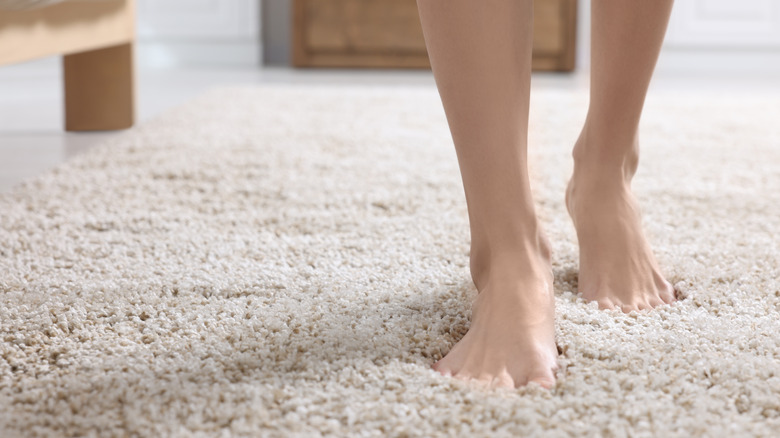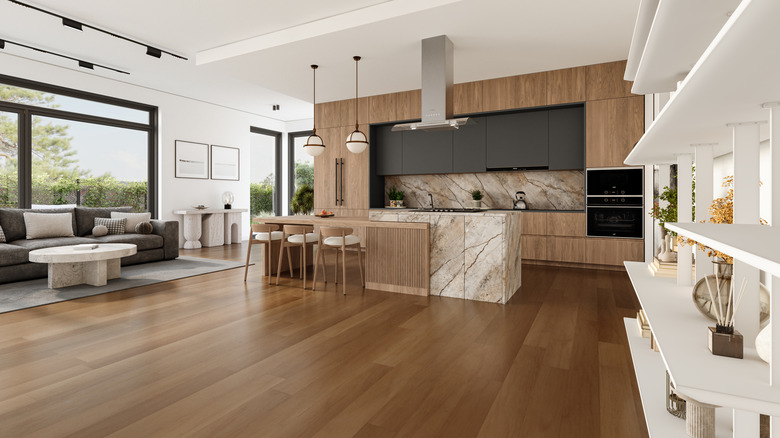Here's Why Millennials Despise Carpets (& The Flooring Alternative They Prefer)
Millennials aren't afraid to share their opinions—and their take on carpet could not be more clear. The generation of people born between 1981 and 1996 are foregoing carpet in their homes, and largely pushing the once-popular flooring option to the back burner for remodels and new builds. In 2023, millennials buying homes were the largest group of home buyers total, and accounted for 38% of total sales. With that corner on the market, builders and sellers are having to consider millennial preferences when designing spaces that appeal to them.
As for why millennials are turning their nose up at carpeting, practicality is a major component. Carpets get stained, and stains take time to clean up. Not only that, but they can trap allergens or other toxins that vacuums can't always reach. With their busy lives and careers — and with the wear their spaces see from frequent gatherings, at-home work, and pet companions — this is simply unappealing to the millennial generation.
Then there's the aesthetics. While not all carpet in ugly on its own, millennials favor natural-looking elements in their spaces, rather than the coziness of carpet that previous generations preferred. Millennial style preferences tend to favor minimalism and low maintenance in their designs, and love a blend of modern convenience and nostalgic design. They also favor some rustic elements and natural coloring, and carpets don't always meet that mark.
Millennials care about clean, healthy spaces
In a post-COVID world, millennials became passionate cleaners. In fact, a 2021 survey conducted by SC Johnson found that the age group in question spent more time cleaning per week than any other generation. It would reason to follow that carpet, a surface that is not easily cleaned, would pose issues for millennials. While vacuuming can certainly get up some of the things a carpet eats up, stains and smells can linger even after the most thorough scrubbing.
Additionally, health is on the group's mind, as grime from shoes, germs from friends, and bodily fluids from pets and animals pose a bigger risk than ever before. Carpet, it turns out, traps all of that in a way that's hard to outrun. The American Lung Association went so far as to suggest that people replace carpet with hardwood flooring to prevent pollutants and allergens from building up and get trapped in carpet fibers.
What materials to use instead of carpet
If millennials are so against carpet, what kind of floors are they using in their homes? Well, there's always wood — the can't-go-wrong classic has positive benefits on air quality, has far fewer or no unwanted chemicals when compared to carpet, and can be a lot easier to clean.
However, interior designer Ted Maines told New Home Source Professional that, while wood is a popular, current demand lies elsewhere. "The demand is also very high for porcelain tile, especially now that large format tile is readily available. In big spaces, we have been working with 24-inch-by-48-inch size tiles, providing a custom look with less grout lines," he said.
In addition, laminate and vinyl floors are popular picks. Both options are cost-effective, easier to keep clean, and mimic the coveted look of real wood. Laminate is scratch and stain resistant, but it can't be refinished, is prone to fading, and is not water resistant. For its part, vinyl is moisture resistant and can last decades, but it can be dented and show some wear overtime. However, there's one thing that millennials may prize above all else when they're getting ready to choose the best floor option: practicality matters more than aesthetic.


